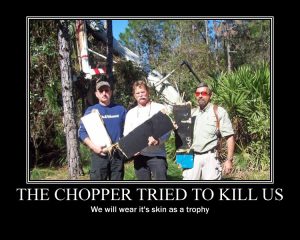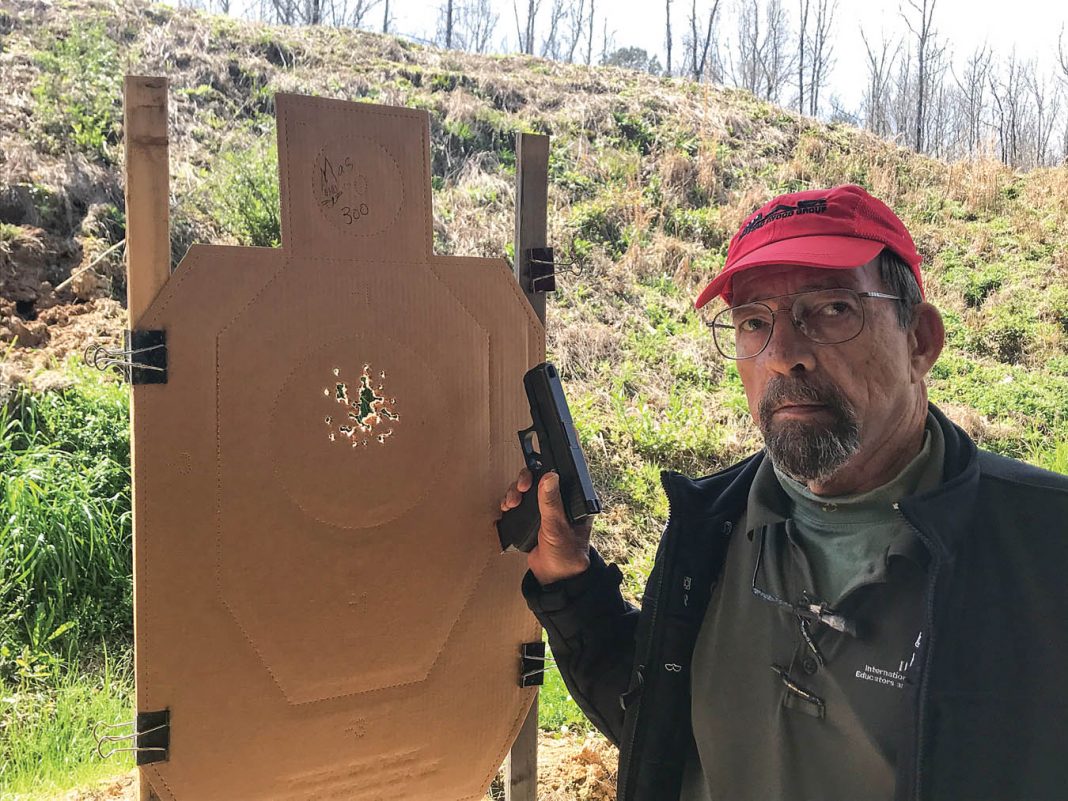Yee-haw! Today, my buddy John Strayer and I are “one year helicopter crash free.”

A year ago we and pilot Graham Harward managed to walk stagger away more or less intact from what one commentator called a “hard landing.” Yes, as a rule of thumb, “landing” upside down is hard whatever the conveyance.
We’re all completely recovered, and the scars are just souvenirs. No lawsuits; we knew what we were getting into when we stepped aboard the helicopter.
The incident, like all such things, gave each of us involved a sharpened appreciation of the people we love, and the people we serve. (We all got a pretty good dose of adrenaline and survival euphoria, too.)
Thanks to all for the kind support after it happened. Lessons came from it. John had a gun in hand when we lost power, and the bird went down too fast for him to holster; I’ve mentioned his impressive trigger finger discipline in every firearms safety lecture I’ve given since, and discussed it more in Guns Magazine.
Another lesson, of course, is that our being helicopter crash free may just have something to do with neither John nor I having been in a helicopter since. Our significant others both told us in no uncertain terms:
NO. MORE. HELICOPTERS. EVER!!!
We have replied,
<Ummm…maybe bigger helicopters? With newer engines…?>
Our pilot, of course, has been flying ever since, doing contract helicopter work, and doing just fine.
But, seriously, thanks for caring. They tell us to live every day as if it was our last. If I had done that, I would have given all my stuff away and the funeral director would be wondering where the body is for the last 51 and a half weeks. Perhaps it suffices to live every day as if it might be your last, and try like hell to do something good with the time.



Hey Mas,
Helicopters are a dangerous beast. I was fortunate enough to be able to do 3 consecutive ride alongs as a medical student on a helicopter air ambulance. Between weeks 2 and 3 there were 2 separate fatal med heli crashes in the US. It definitely made me nervous, but being able to see how professional this organization was made me feel more comfortable. Heres to those men and women who risk it every day saving lives in the most dangerous civilian profession.
-Adam
Glad you all made it.
Amen to that Mas! Add me to the list of folks that are glad you’re still drawing air.
I had no idea. You are a member of an elite club! Wear it’s skin/parts with pride. Jpchiesa LFI Class 6/93.
Dear Mas,
I’m glad you all came out alive and without grave damage. My dad also had a helicopter accident. ShOrtly after takeoff there was trouble with the rotor and controls failed. He and the pilot actually had to jump out. Luckily they weren’t very hogh up when it happened, he recovered with large scrapes on the palms on his hands (from cushioning the fall) and cracked ribs. The pilot was a bit worse off but survived relatively damage free as well. The helicopter was thoroughly destroyed and the first rescuers thought they’d only recover corpses. I was only 5 or 6 at the time and still remember my dad bed ridden.
Did a year riding around in the back of Hueys and jumping into jungle clearings. My claim to fame is that no one in my platoon earned a Purple Heart.
My theory is that the only reason helicopters get off the ground is that the pilots are crazy enough to believe they can fly.
I’m the one who made that motivational poster, made to me smile to see it again.
Thank you, James!
They say any landing you walk away from is a good one. Glad that one was good enough you guys could walk away.
I had a pretty cool long ride over Sedona, felt like sitting on my living room sofa. Lucked out maybe. WTF loud if you took off ears.
I’ve really come to appreciate the air ambulance system. I’ve seen 3 pick ups in the past three years from accidents in rural areas around my work area but the there have been a couple of fatal crashes involving local crews in that time also. I think I will hunt from the ground or well tethered in a tree stand!
Just glad to see everyone is still alive and kicking after 1 year! Thank God for that.
Having spent a fair amount time maintaining aircraft, a good landing is one you can walk away from. A great landing means you can fly the aircraft again.
But sometimes good is what you need.
Best to you and Gail. Glad your still around,
Congratulations! I’m glad you made it a whole year! Good luck on another year crash-free!
Mas, the memorable photograph of The Three Amigos who survived the “hard landing” helicopter crash reminded me of an Army Airborne “Black Hat” Trainer instructing us trainees what to do if our primary parachute failed to deploy and if our reserve chute also failed to deploy. He stated, in a thick southern drawl, “Remain calm, extend your arms and legs to slow your descent, and look down in an effort to locate coniferous trees to cushion your impact.” Being a smart ass with the identifier “C47” taped to the front of my helmet, I immediately extended my arms and legs and pretended to be descending toward terra firma at ultra high speed. At the same time, I swiveled my head from side to side and said, “I gotta spot me some coniferous pines, because all I see right now are elms and oaks.” All of my classmates burst out laughing, but none of the “Black Hat” Trainers present were amused. Uh oh. Oh yeah. I was bleeping doomed. For the remainder of the three week long Airborne Training Course, every single “Black Hat” Trainer referred to me as “Coniferous” and made C47’s life at Fort Benning GA a living Hell. Lesson 1: STFU. Lesson 2: Refer back to Lesson 1. FWIW, I hated parachuting from helicopters, but I had no problem jumping from C-123s, C130s and C141s. To this day, I dislike helicopters. Go figure.
Any landing you can walk away from is a good landing! Keep Safe!
Damn bad luck sir! I spent 29 years in the Navy and was blessed to be able to fly for 16 of those. Over 3500 hours with over 3,000 in helicopters. Fortunately I never experienced landing upside down. However, I lost some friends to helicopter crashes. So glad we – your fans and students – didn’t lose you. Hopefully it was lots of fun until the landing.
The 3 amigos zero the hogs one. I still wonder about those psychedelic glasses. Glad you guys made it.
We refer to helicopters as “a collection of nuts, bolts and moving parts searching for the worst place to have an accident.” Fixed-wing aircraft are MUCH safer and small airplanes, even suffering an engine failure, will get you to the ground relatively intact. Rotary-wing aircraft (helicopters) can do great things but have their own inerent deficiencies when a failure occurs. Try a small Cessna for your next flight.
I’m reminded of a song I heard Johnny Winter do, “Still alive and well. Every now and then I know it’s kinda hard to tell but I’m still alive and well”. Glad that you are, sir.
At one time, while assigned to an air branch, where I worked for four years, and old Ex-Helicopter Instructor Pilot told that that he firmly believed that the Hueys he flew, and trained others to fly, was the aircraft he had experience with, that “Sat out on the ramp, all night, plotting and planning, “How to KILL the first Pilot who arrived the next morning, with the stupidity to try to fly it””.
I can say is that during that four years, the only people that we had who died in an aircraft were the pilot, and his observer, who were aloft in one of our “On loan from the Military” Cobra helicopters.
Glad it wasn’t y’alls time…
I don’t have a problem with flying, but never went up in one of those and will do whatever I can to keep avoiding it. The damn things are insane. Glad you made it in one piece, Mas!
Glad you’re still with us Mas!
Lesson learned, Helicopters + Wild Pigs do NOT mix.
Mas – I’m sorry I forgot about this particular one year anniversary, but I am very glad you’re still around for it.
http://www.ntsb.gov/aviationquery/GenPDF.aspx?id=ERA13LA118&rpt=fa
Sooooo lucky!!
It’s been 35 years since I’ve flown a carburated aircraft, but I’ve never heard of carb ice at cruise power.
@ Sharpshooter
As I recall, whether you can get “Carb Ice”, at whatever speed, depends on the humitity in the air, and the temperature.
So, a carburated aircraft can get “Carb Ice”, at any speed, if there is enough mosture in the air, and the Temperature drops enough, so applying “Carb Heat” is the thing that will save your ass, and the aircraft, if it starts running rough, at any time.
@ Paul Edwards.
You’re right, I suspect (can’t verify, and too lazy to do it), and thinking back I do remember one key factor was using carb heat in visible moisture conditions (and pitot heat).
Also, IIRC, Lycoming’s were more prone to it than Continental’s. I suspect Franklin’s were/are even more prone. Having done all my flying in the dry Rocky Mountain West, it wasn’t a factor like it would be in Florida.